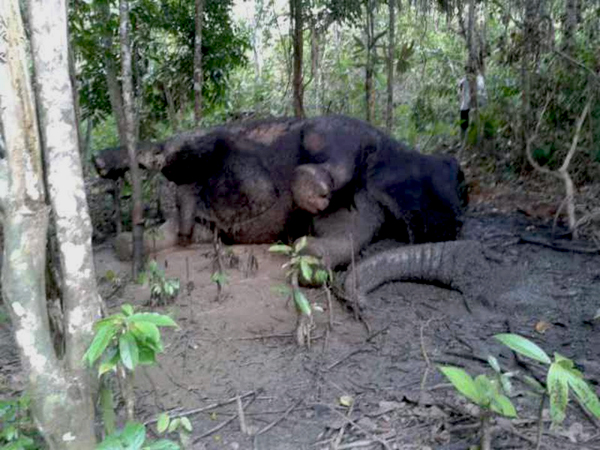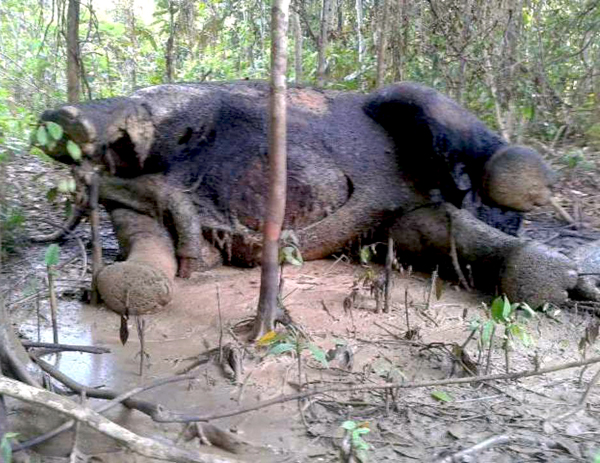
A bull elephant was found dead in West Aceh on April 13. Its tusks were missing; its trunk was severed from its body. Photo: Khaidar
A pair of critically endangered Sumatran elephants (Elephas maximus sumatranus) were found dead this month in Indonesia’s Aceh province, just the latest casualties for a species that has been brought into increasing conflict with humans amid the country’s oil palm boom.
First, on April 13 in Kareung Hampa village, West Aceh regency, a bull elephant was found with its tusks missing and trunk severed about 150 meters from an oil palm estate belonging to Agro Sinergi Nusantara. It was thought to have perished a week earlier.
An autopsy revealed a bullet hole in the elephant’s head, likely the work of poachers in search of ivory, according to Genman Suhefti Hasibuan, the head of Aceh’s Natural Resources Conservation Agency (BKSDA).
Poachers have exploited the rising frequency of human-wildlife conflict to kill bull elephants near residential areas, he added.
“They slaughter elephants as is often done by people whose gardens they damage,” Genman said.
Then, on April 20 in Seumah Jaya village, East Aceh regency, residents alerted the authorities when they saw an injured elephant hobbling near their fields. Its right leg had been injured in a snare trap.
“The people immediately reported it to the BKSDA so the elephant could be treated and evacuated,” said Syahrul, a resident.
The creature perished shortly thereafter.
Since 2012, around 200 Sumatran elephants have died out of a population of 1,700, according to the Indonesia Elephant Forum (FGI). Aceh alone has seen 36 casualties.
Environmentalists cited weak law enforcement as a major culprit.
“If the law is not enforced to prevent the killing of elephants, we could see their extinction in 10 years,” WWF-Indonesia’s Sunarto said.
The cases of elephant deaths, he added, are inseparable from human-wildlife conflict that has arisen as a result of the widespread conversion of elephant habitat into oil palm plantations.
“We need a comprehensive system overhaul and rearrangement of plantation zoning that do not threaten the habitat of protected wildlife like the Sumatran elephant,” Sunarto said.
Acehnese environmental activist TM Zulfikar also urged the government to better protect the elephant.
“Everyone is waiting for concrete action from the government, especially law enforcement officials, to apprehend and prosecute wildlife poachers in Aceh,” he said. “This must be done, otherwise we will know [the Sumatran elephant] by name only.”
Produced in English by Philip Jacobson.

Another image of the dead bull elephant from West Aceh. Photo: Iwan
Citations:
- Chik Rini. “Tragis! Indonesia Kehilangan 200 Gajah Sumatera Dalam 3 Tahun Terakhir” Mongabay-Indonesia. 17 April 2015.
- Junaidi Hanafiah. “April Ini, Dua Gajah Sumatera Ditemukan Mati di Aceh” Mongabay-Indonesia. 25 April 2015.